MARK BANDO'S WEBSITE
LEST WE FORGET
Unforgettable
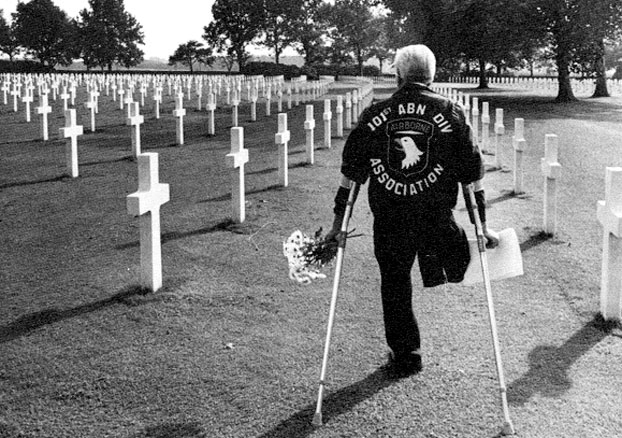
In this photo, taken 21 September, 1987, Bill Guarnere of E/506th, remembers comrades slain during Market-Garden. This is their final resting place, at Margraten, Holland. Bill, who lost a leg at Bastogne, is carrying flowers and a list of grave locations. This photo is worth a thousand words. It appeared on the back cover of the Screaming Eagle magazine, November-December issue of 1987. I think of this photo often, and can't forget it.
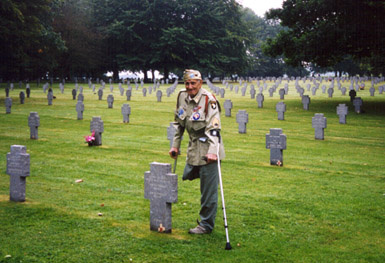 In September of 2002, I encountered Wild Bill at the German Military Cemetery at Recogne, Belgium, north of Bastogne. In this 'Soldatenfriedhof' are 6700 Germans who died in the Battle of the Bulge. It must be an odd feeling to stand there and to know that you personally put some of them there. For decades after WW2, German highschool students came to manicure the lawns and tend these graves, as a reminder of the cost of war.
In September of 2002, I encountered Wild Bill at the German Military Cemetery at Recogne, Belgium, north of Bastogne. In this 'Soldatenfriedhof' are 6700 Germans who died in the Battle of the Bulge. It must be an odd feeling to stand there and to know that you personally put some of them there. For decades after WW2, German highschool students came to manicure the lawns and tend these graves, as a reminder of the cost of war.
Each month on this page, I will honor the memory of a fallen 101st trooper who was killed in action during WW2. As in all wars, some of the finest men who served were killed before their time-we can only speculate on what miraculous contributions they
might have made to the world, had they survived. Among the 101st
fallen were artists, musicians, writers, skilled athletes, scientists and mathematicians, architects and builders.
Above all, there were sons, brothers, lovers, friends, (and in some cases), husbands and fathers, whose caring and
vibrant personalities are missed by those they left behind. The human race is diminished by their loss.
Copyright Mark Bando, 2014
Msg from the Webmaster, March, 2015
Due to technical html issues with the server, which I have been unable to resolve, I have been unable to amend,
supplement or otherwise update this web page. For now, I've decided to leave the existing Trigger Time website
up, as it is, to provide information and photos. However, new info, which would've appeared on this page, is now being
presented on a private Facebook Trigger Time page. If you'd like to join, you'll need a invitation.
Email me at: markbando@aol.com, requesting an invitation to join and I will facilitate the process.
Thanks to all who have visited this page, since year 2000, when it began. M. Bando
*Photos and information on these pages Copyright Mark Bando*
Remembering the Fallen 101st Airborne Heroes of the Battle at Graignes, France
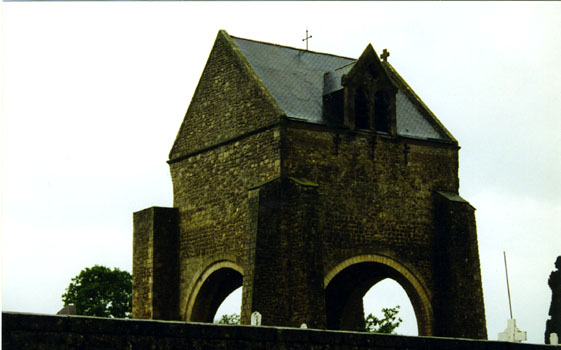 In 1989, I first learned about the obscure fighting at the isolated town of Graignes, from Frank Juliano, a veteran of B/501 PIR, who had been mis dropped there on D-day. Frank was left behind around 11 June, 1944, when U.S. forces evacuated the town and he was hidden from German forces in the large bread baking oven of the town baker, until the place was liberated by the 29th ID. (Mr. Juliano later founded the Allied Airborne Assn, for WW2 Airborne vets in the NJ area).
In 1989, I first learned about the obscure fighting at the isolated town of Graignes, from Frank Juliano, a veteran of B/501 PIR, who had been mis dropped there on D-day. Frank was left behind around 11 June, 1944, when U.S. forces evacuated the town and he was hidden from German forces in the large bread baking oven of the town baker, until the place was liberated by the 29th ID. (Mr. Juliano later founded the Allied Airborne Assn, for WW2 Airborne vets in the NJ area).
In more recent years, around the 60th anniversary of D-day (2004), the History Channel did a 1 hour documentary on the fighting at Graignes, largely using Marty Morgan's research on the 507th PIR. Around the same time, NBC
did a similar documentary on the same subject, hosted by Tom Brokaw. Both documentaries were well-done, in explaining what happened there and why, but I was disturbed that there was no mention of any 101st Airborne personnel being involved in the Graignes fighting, in either of those TV documentaries. In one of them, a reenactor with a diamond painted on the side of his helmet was shown for about 2 seconds, but with no mention of the reason why, and no mention of the fact that 2 planeloads of troopers from 1st battalion 501 PIR, 101st Airborne Division had also been misdropped in the Graignes area and had also fought there, side by side with members of the 507th PIR of the 82nd Airborne Division. Considering that a dozen members of the 501/101 were killed in the fighting there, this tragic oversight and omission needs to be corrected.
So I will create a small memorial tribute to the 501st guys who were KIA at Graignes and show the faces (of those who I have pictures of), lest they be forgotten. Since approximately 50 Americans were killed in that area from the 82nd and 101st combined, the fact that one in four KIAs was a 101st trooper is a significant percentage.
The fact that this remains mostly unacknowledged was again brought to my attention in June 2012, when Col. Keith Nightingale delivered a speech about Graignes at an American Legion dinner in Normandy. I was in the audience and the colonel again made NO MENTION of any 101st Airborne personnel being involved in the fighting at Graignes. Then, to add frosting to the cake, Ellen Peters remarked to me at dinner in February, 2013, that the 101st didn't need to be mentioned in connection with Graignes, because "something like two soldiers from the 501st were killed there". That statement, expressing an honest but misled belief, was what motivated me to post this remembrance to the 101st Airborne casualties of Graignes. After Graignes was overrun by numerically superior German forces on 11 June, 1944, the American survivors fled the village, most heading NW across the swampy marais, others going southwest and a few even making their way east. Most of those who were unfortunate enough to be captured, were systematically executed.
I will start by posting a list of names of 101st Airborne soldiers who were killed in the Graignes area in various ways, either in open combat, or ambushed while escaping or murdered while prisoners of war:
Captain Loyal Bogart (C.O. of Baker Co. 501st PIR)
Pfc George A. Brown, B Battery 81st Airborne AA/AT Bn
T/4 Roy Callahan B Co. 501 PIR
Pfc Richard J. Hoffman HQ Co 1st Bn 501 PIR
Pvt William H. Love HQ Co. 1st Bn 501 PIR
Pfc Hugh J. McFadden B Co. 501st PIR
T/5 John McNally B Co. 501st PIR
Pvt Jimmie S. Millican HQ Co. 1st Bn 501 PIR
Cpl James M. Naff (medic) 1st Bn HQ Co. 501 PIR
Pvt James A. Nebeling Medical detachment 501 PIR
T/5 Leo J. Packham HQ/1 501st PIR
Pvt Peter Sass B Co. 501st PIR
Pvt Herbert Weiss B Co. 501st PIR
On the night of the drop, planes carrying Headquarters Company 3rd Bn 507th PIR, 82nd Airborne Division misdropped that entire company of over 150 troopers in the Graignes area. After they had assembled, the 507th commander decided to fortify the town with mortars and machine-guns retrieved from the equipment bundles and make a stand there, until Allied forces coming from the beaches could liberate that area. Captain Loyal Bogart the C.O. of B/501 was seriously wounded by ground fire while still aboard his C-47. He could have returned to England on the plane, but instead, he opted to jump in to France, a heroic decision that would later prove fatal. A first aid station was established in the Graignes church and Bogart became one of the first patients. When the town was overrun a week later, Bogart was captured along with Captain Abraham Sophian, the 3/507th surgeon. While the other wounded were almost immediately massacred after being captured, those 2 officers were taken to the nearest town of any size (Tribehou, France) and after being interrogated, were knelt in a roadside ditch and executed together. Due to tall grass covering the bodies of Captains Bogart and Sophian, they were not located and recovered until the spring of 1945.
Richard Hoffman and William Love were taken with seven other prisoners (mostly 507th troopers), to the hamlet of le Mesnil Angot, about 3 Km south of Graignes. They were marched 11 fields west from the church, then marched off the road, to a place where two intersecting ditches separated 4 farm fields. One by one, these nine troopers were knelt down and shot in the back of the neck. Their jump boots were stolen and the Germans tossed loose dirt over their bodies. Two or three days later, a 17 year old French farmer saw the stockinged toes of the deceased sticking up out of the dirt and the bodies were recovered by GRS personnel, after the area was liberated. The farmer who discovered the bodies took Richard Hoffman's younger brother Phil to the exact spot where the massacre had taken place, when we visited in one of my tour groups, circa 2005.
There were many more 101st men who fought in the area, but most of them escaped during the withdrawal. I know Lt George Murn
was there, as was Chester Brooks (both HQ/1/501) and John Piotrowicz (B Co.), who I interviewed 30 years ago. John escaped during the general withdrawal from the town but was captured some distance away from the town, a day or two later. Four other troopers who initially escaped Graignes on the 11th decided to head east, instead of north. A day or two later, they were ambushed and two of them were killed, while the other 2, including B Co. 501st supply sgt George Faulkner, were taken prisoner. The 2 troopers who were killed in that ambush were Jack McNally of B/501 and George A. Brown of B/81st Abn AA/AT Bn, whose glider had landed west of Graignes, on D-day morning.
It is interesting to know that on the plaques listing the victims of the Graignes fighting, (displayed in the ruins of the town church), only three of the 101st names listed above, are posted. This was certainly not a deliberate oversight, but resulted from the chaos of the situation and incomplete information, which continues to surface, to this day.
At this point I want to acknowledge the efforts of researcher Brian Siddall, who not only supplied most of the names for 501st Graignes casualties, but who might someday publish a book on the subject.
In the near future, I plan to start posting photos of the faces of most of the KIA 101st troopers listed above.
FACES OF SOME OF THE 501st PIR DEAD FROM GRAIGNES, FRANCE
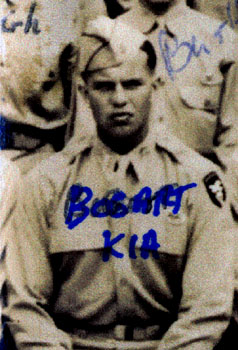
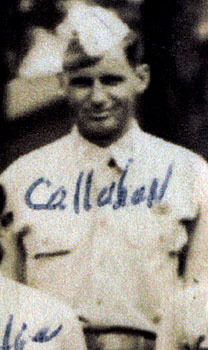 Above left: Captain Loyal Bogart, company commander of Baker Co. 501 PIR
above right: Roy M. Callahan B Co. 501 PIR
Above left: Captain Loyal Bogart, company commander of Baker Co. 501 PIR
above right: Roy M. Callahan B Co. 501 PIR
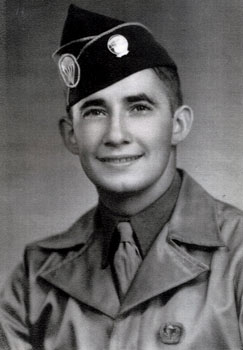
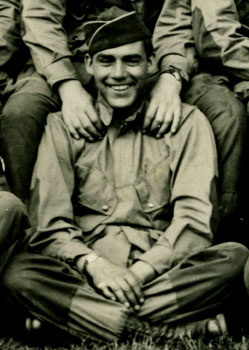 above left: Richard Hoffman, HQ Co. 1st Bn 501 PIR Above right: William H. Love HQ Co. 1st Bn 501 PIR
above left: Richard Hoffman, HQ Co. 1st Bn 501 PIR Above right: William H. Love HQ Co. 1st Bn 501 PIR
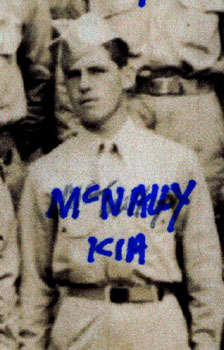
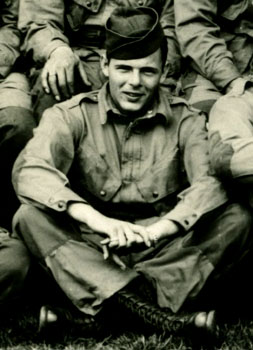 Above left: John McNally, B/501st mail clerk Above right: Jimmie S. Millican HQ Co. 1st Bn 501 PIR
Above left: John McNally, B/501st mail clerk Above right: Jimmie S. Millican HQ Co. 1st Bn 501 PIR
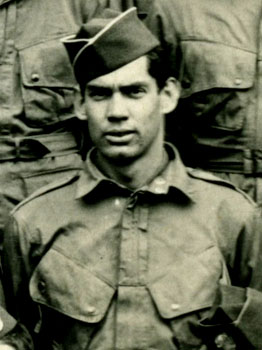
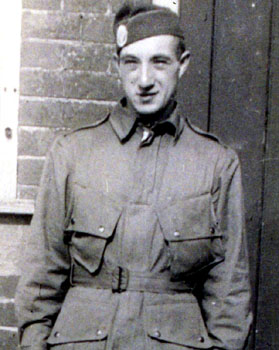 Above left, Leo J. Packham, HQ Co. 1st Bn 501 Above right: Herb Weiss from Detroit (he pronounced his last name WEEss), Company B, 501 PIR.
Above left, Leo J. Packham, HQ Co. 1st Bn 501 Above right: Herb Weiss from Detroit (he pronounced his last name WEEss), Company B, 501 PIR.
Site where Richard Hoffman, William Love and 7 Others Were Murdered
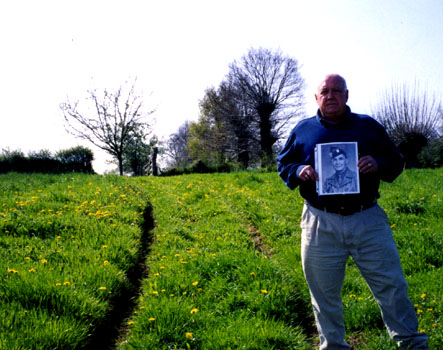 In the back of this field (near the trees), 9 U.S. paratroopers of 3/507 and 1st 501 were systematically shot in the back of the neck, while prisoners of war.
In the back of this field (near the trees), 9 U.S. paratroopers of 3/507 and 1st 501 were systematically shot in the back of the neck, while prisoners of war.
In this photo, taken in 2004, Richard's younger brother Phil Hoffman makes his first pilgrimmage to the spot.
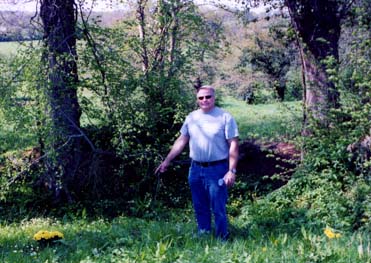 2 Ditches converge at right angles here, dividing the area into 4 fields. This is the precise spot where Richard Hoffman and 8 others were executed,west of le Mesnil Angot, France. A French Digger later discovered 9 spent slugs, embedded in the ground here.
2 Ditches converge at right angles here, dividing the area into 4 fields. This is the precise spot where Richard Hoffman and 8 others were executed,west of le Mesnil Angot, France. A French Digger later discovered 9 spent slugs, embedded in the ground here.
Epilogue: Since the 501st strays were considered of less importance to the 3/507th commanders than their own men, they were put in expendible positions, such as far flung outposts, on the approaches to Graignes. As such, some of them probably perished away from the larger group, with their fate known only to the Germans who killed them. Lt. George Murn of the HQ Co 1st Bn.501st LMG platoon, was posted at the bottom of the road which winds downhill from a place just west of the church. He manned that outpost with Earl Tyndall C/501, and Robert Wickham (1st Bn S-2 section). These troopers were 1/2 mile away from the main force, but they managed to escape, by heading due west, after the village was overrun on 11 June.
Saluting a Fallen Hero
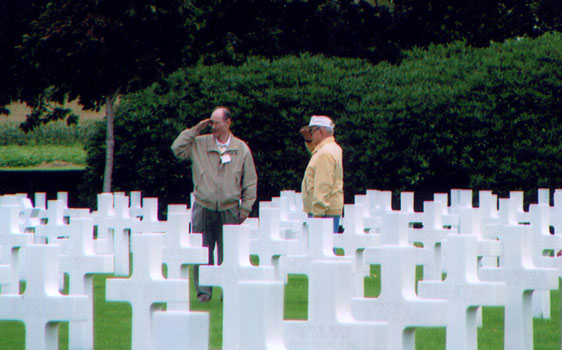 Standing amid a sea of white marble crosses, in the US military cemetary at Margraten in 1994, this un-posed photo was made of Hilly Rosenthal and Dan Olney of C/501, saluting the grave of a fallen comrade.
Standing amid a sea of white marble crosses, in the US military cemetary at Margraten in 1994, this un-posed photo was made of Hilly Rosenthal and Dan Olney of C/501, saluting the grave of a fallen comrade.
Tom McNabb was KIA 28 September, 1944, and this visit fifty years later, was the first pilgrimmage these guys made to their buddy's grave-photo courtesy H. Rosenthal
(note from webmaster-we lost Hilly in early 2007-a great guy, he will be missed.
R.I.P. my friend)
One of our Finest Officers-A Remembrance by E.O. Parmley of F/502PIR
"Time has not made me forget the wonderful soldiers I served with over sixty years ago.
Time has only deepened the feelings of respect and gratitude I have for them.
Our platoon leader 1st Lt Nick Schlitz assigned me to accompany Lt. Wolfe (a replacement and 2nd in command), to bring-up the rear of the platoon. This is a much safer position than platoon runner, which is what I was when assigned to him. He knew it was going to be a rough day (18 September, 1944, at Best, Holland). I feel he was protecting me, possibly saving my life.
Lt Schlitz was one of our finest officers.
Tall, with a boxer's nose, he was state boxing champion in his weight division, from Charlotte, N.C. He was the image of a soldier's soldier. We called him 'The Scar', so he must have had a scar on his face. I do not remember a scar. It could be we do not remember imperfections on people we like.
Always optimistic, his favorite saying was 'We are going to Berlin.' We heard it when in formation or on breaks. He would say it to a picture of his son, which he carried inside his helmet. His son looked to me to be only 2 or 3, but he would look at him whenever the helmet came off and usually it was 'son, we are on our way', or 'Berlin, we are coming.'
When he said nothing, I often wondered what he was thinking.
He was killed that day and buried close to where he fell in the courtyard of a house on the outskirts of Best, with a wall about 4 feet high enclosing the yard about 40 feet square. I found his grave about the center of the yard. His helmet was on a rifle butt with a bayonet stuck into the ground. It was not his, as he carried a carbine.
I saw no other graves in the courtyard. I looked into his helmet to see if the picture was still there ...and it was. I thought of taking the picture with me.
It then came to me: This picture is all this soldier has. HE has nothing else. It should stay here. His happiest moments seemed to be when he was looking at the picture and talking to his son.
I put the helmet back on the rifle butt. Looking up with smiling welcome were fresh flowers, put there by the Dutch people. It was so peaceful and quiet I was reluctant to leave. I could still hear him saying we are going to Berlin, but now it will only be his words that go, they are not buried here.
They are buried in the hearts of all who heard them.
He has shown us what it will take to get to Berlin.
The road is rough and dirty, with many holes that await us, but it is the only road.
Few will have flowers on their graves. Some will have no one to mourn them. But all who knew him will have his
words and his order, which is 'on to Berlin'."
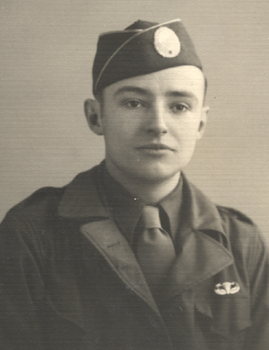 This is a 1945 photo of E.O."Jess"Parmley, who wrote the tribute to Lt. Schlitz
This is a 1945 photo of E.O."Jess"Parmley, who wrote the tribute to Lt. Schlitz
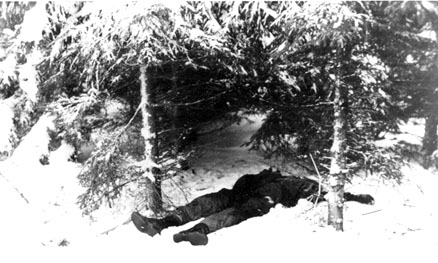 January, 1945, a paratrooper of the 501 PIR lies dead in the snow in the Bois Jacques forest, northeast of Bastogne, Belgium
January, 1945, a paratrooper of the 501 PIR lies dead in the snow in the Bois Jacques forest, northeast of Bastogne, Belgium
POEM
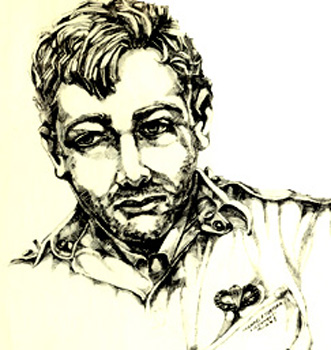
We have only died in vain if you believe so
You must decide the wisdom of our choice
by the world which you shall build upon our headstones
And the everlasting truths which have your voice.
Though dead, we are not heroes yet, nor can be,
'Til the living by their lives which are the tools,
Carve us the epitaphs of wise men
and give us not the epitaphs of fools.
-David J. Phillips, 506th PIR
MARK BANDO'S WEBSITE
Sad Physical Evidence of a Tragic Plane Crash
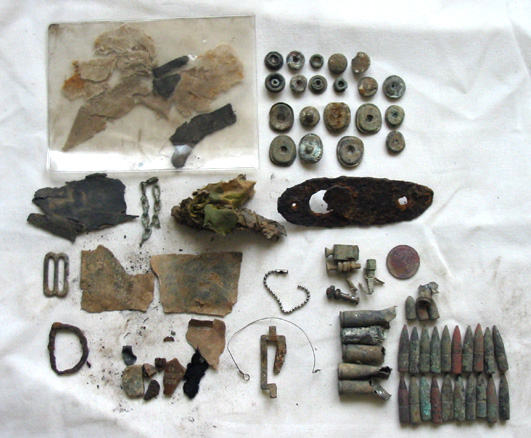 Most visitors to this website are familiar with the D-day plane crash of a C-47
chalk #66, bearing members of Company Headquarters, Company E, 506th PIR. This famous group, immortalized in the book and
film 'Band of Brothers' included 1st Lt Thomas Meehan, then Easy Company commander, and 1st Sgt William S. Evans.
Most visitors to this website are familiar with the D-day plane crash of a C-47
chalk #66, bearing members of Company Headquarters, Company E, 506th PIR. This famous group, immortalized in the book and
film 'Band of Brothers' included 1st Lt Thomas Meehan, then Easy Company commander, and 1st Sgt William S. Evans.
The artifacts pictured above, were recovered from the crash site between Beuzeville au Plain and Haut Fournel, France, both
locations east of St Mere Eglise, on digs by Sgt Nico Jongneel of the Dutch Army, in 2003, 2004, 2005 and 2006. Numerous
other individuals have been recovering items from this site for over 20 years now, and some of the objects, including dogtags,
are pictured in the book entitled 'Forrest Guth', by Michel deTrez.
Sgt Nico was kind enough to pass along some of his
discoveries to the webmaster of this site, in the interest of sharing the objects with the larger Trigger Time audience.
The items pictured include:
pieces of M42 jumpsuit, including metal snaps.
Lift a dot fasteners of two sizes, for carbine clip pouch or .45 clip pouch (smaller ones presumably for a compass case).
Black rubber pieces from assault gas mask bag
Pieces of chain from canteen cap
Partially-melted green camouflage parachute canopy
The buttplate from a M-1-A1 Thompson sub-machinegun
A Mae West life preserver clasp
Two pieces of metal plate from the C-47 fuselage
Small dogtag chain
Two C-47 mass earth connectors
One British coin (penny)
D-ring from gasmask bag
Assorted cartridge casings(broken/ruptured) and projectiles for caliber .30 M1-A1 carbine and 30-06 M-1 rifles.
As would be expected, the 30-06 projectiles are a combination of black-tipped armor piercing and
red tipped tracer rounds.
It is likely that the TSMG butt plate belonged to 1st Sgt Evans, as he was most likely to have been armed
with a Thompson, of all the troopers aboard. The carbine may have belonged to Lt. Meehan or one of the
Technicians on board.
The following are excerpts from two emails sent to me by Sgt Nico, giving more historical background to the
artifacts he dug up at the Meehan plane carsh site:
"I spoke to a farmer in Beuzeville before I entered the fields of the crash site. He spoke to me for several
hours on the subject. He told me he was aged 11 at the time (June, 1944) and it was night when the impact took
place. The family was inside the house at that moment (he lives in front of the church). When the plane impacted,
all the porcelain was smashed out of their cabinet by the force and the house shook on its foundation.
They went outside to look what happened and through the trees, they saw the wreckage burning for days to come.
In his back yard, paratroopers were landing with their blackened faces. Some of them he told me, had bronze and
steel boxing knuckle bows on their fists. Some German soldiers who were in these fields, mostly young boys, had
their skulls smashed-in with these. The paratroopers did not take prisoners. Some of the German boys cried of fear
and sat down in a trench. They were all killed by trench knife or bayonet.
Meanwhile, the wreckage was still burning but nobody dared to go there, because of the constant explosions of
ammo still burning all around.
I stood there with my mouth falling open, listening to that farmer's story. He kept going for hours and I don't speak
a word of French, but my wife was with me, translating for me. Finally she told me 'let's go', otherwise I think I
would be there until this present day. Because darkness came up, I decided to return the next day, armed with my
tools and detector.
I knew already that the largest part of the site had already been scavenged by relic hunters, so I took the fields
surrounding the site...my son who was aged six at that time, started to pick-up artifacts from the ground and came
running to me. When he opened-up his little hands, there were several green oxidized and black burned M-1 rifle bullets
in them. At that moment I knew there was more. When I took a closer look at the ground, the place was filled with
ammo parts, small metal fragments and pieces of clothing. I started to dig for many nights in the side of a hedgerow
and there I found all these artifacts.
In the corner of that field is a large gap near the hedgerow from approximately 50sqm, where the corn never grows.
When body fluids contact the earth, it poisons it, that's why the corn does not grow on that spot.
I spent a lot of time, mostly at the evening, with my dad and John 502, to get small artifacts from beneath the surface
before other relic hunters do and sell them for awesome prices on the Internet.
I know the Forced Landing group dug out the main treasure before we came. Nobody knows what happened with these
items, they are all gone.
I dug in several areas surrounding the crsash site and found a lot of small artifacts belonging to a rifleman who
was smashed from the wreckage, through the hedgerows. I even found remains of his fragmented 1942 jumpsuit, lift the
dot buttons, a small English coin (see photo), lots of exploded rifle and carbine ammo, pieces of burned webbing and
other small objects. These are all 100% sure from Meehan's plane.
My main target of these actions is to keep several pieces of history safe for future generations to come, so we can
learn from it.
I know that your heart has a good place for the 101st, so that's the main reason...to hand the artifacts over to you."
-Nico Jongneel, 20 January, 2008.
Thanks again to Sgt Nico for this contribution to Trigger Time.
Was Mysterious Photo a Harbinger of Combat Death?
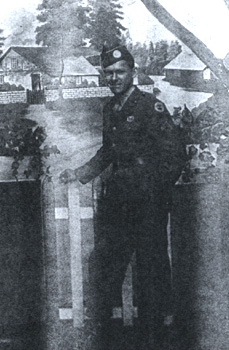 Corproral Bert James Coder was a paratrooper from Kansas
City, MO and a pre-war friend of John Luteran (I/506th). Before going overseas, to fight in the
Pacific Theatre, Corporal Coder went to a photo studio and had the above picture taken. For some
reason, a mysterious light spot appeared over two boards of the picket fence, giving the appearance
of a white cross. Upon seeing this photo, Luteran's dad remarked "He won't be coming back!"
Corproral Bert James Coder was a paratrooper from Kansas
City, MO and a pre-war friend of John Luteran (I/506th). Before going overseas, to fight in the
Pacific Theatre, Corporal Coder went to a photo studio and had the above picture taken. For some
reason, a mysterious light spot appeared over two boards of the picket fence, giving the appearance
of a white cross. Upon seeing this photo, Luteran's dad remarked "He won't be coming back!"
Corporal Coder went to combat with the 503rd PRCT and was killed in action on 6 September, 1944.
John Luteran survived all the missions of the 101st Airborne Division in the ETO and came back alive.
But the Luteran family would never forget the mysterious photo. Carol Luteran, John's widow gave me
a copy of the photo in 2009, so I could post the story here. This will remain one of the haunting
mysteries of a costly and tragic war.
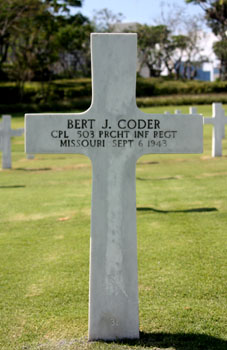 Bert Caloud is an employee of the American Battle Monuments Commission
and he currently works at the US Military Cemetery in Manilla. In March of 2010, he sent this photo of Bert Coder's
grave marker, verifying his unit, date of death and final resting place. Thanks to Geurt v.d.Bogert, 'Hermie'
and Mr Caloud, for getting this photo to me.
Bert Caloud is an employee of the American Battle Monuments Commission
and he currently works at the US Military Cemetery in Manilla. In March of 2010, he sent this photo of Bert Coder's
grave marker, verifying his unit, date of death and final resting place. Thanks to Geurt v.d.Bogert, 'Hermie'
and Mr Caloud, for getting this photo to me.
Remembering A Tragic Mine Accident in Holland
On 22 October, 1944, the 502nd was providing south flank security for the 101st Airborne Division, on the Island, near
Dodewaard, Holland. Seven demolitionists from RHQ were assembled under their section leader, Lt. Richard A. Daly, at a
'Y' junction west of the town. About a dozen German Riegel mines (anti tank mines) had been recovered from the dirt road
where German Engineers had planted them. A table was brought out of a nearby Dutch house and the mines were placed on and
near the table as Sgt Schlensker demonstrated how to open the lid and disarm one of them. The Germans had evidently placed
a anti-tampering device in that particular mine, which exploded, setting off all the other mines stacked nearby. S/Sgt
Schlensker was among those killed immediately by the devastating explosion. Bob Brigham, who had been wounded in LTC Cole's
bayonet charge above Carentan, was fatally wounded and would die in the early morning hours of 23 October. Oreste 'Rusty'
Quirici was blown into the nearby 'canal' (a narrow, water-filled ditch) and was rescued by other Deuce soldiers, although
he lost one eye and part of his leg. Rusty survived until 2005. Lt. Daly and all the others present were killed outright by
the blast. Others killed in this tragic incident included Pfc Edmund Ambrose, Pfc Joseph Hill, George Sheppard, and Joe St
Clair.
Lt. Daly's brother, James Daly, who had survived the Bataan Death March earlier in WW2, returned home alive at the end of
WW2.

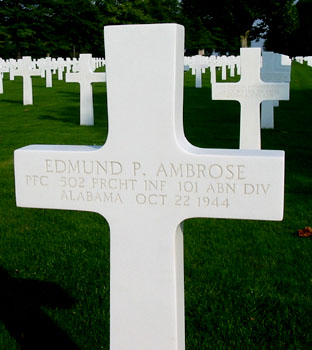 above:Pfc Edmund Ambrose-more photos of victims from this incident to follow.
above:Pfc Edmund Ambrose-more photos of victims from this incident to follow.
 Above, S/Sgt Oswald Schlensker, another original member of regimental HQ 502 PIR
who died in this tragic mine explosion.
Above, S/Sgt Oswald Schlensker, another original member of regimental HQ 502 PIR
who died in this tragic mine explosion.
Tragedy at the Seminary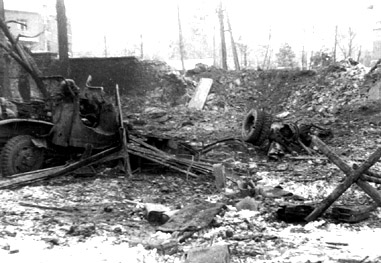 The regimental Command Post of the 501 PIR during the Bastogne campaign was in the seminary across from the church, at the east end of town. On 5 January, 1945, a truck loaded with landmines exploded in the seminary courtyard, killing 12 members of the H&H Demolitions platoon, 501 PIR, and another trooper, who was a driver assigned from Service Company. The photo above, taken by Jimmy Duggins, shows what remained of the truck after the massive explosion.
The regimental Command Post of the 501 PIR during the Bastogne campaign was in the seminary across from the church, at the east end of town. On 5 January, 1945, a truck loaded with landmines exploded in the seminary courtyard, killing 12 members of the H&H Demolitions platoon, 501 PIR, and another trooper, who was a driver assigned from Service Company. The photo above, taken by Jimmy Duggins, shows what remained of the truck after the massive explosion.
According to Charlie Vess of Service Co. 501, there was a sizeable mine dump beside the truck before the explosion, consisting of over 300 additional land mines, which we piled in front of the seminary wall. To this day, nobody knows if a direct hit from a mortar or artillery shell set off the lethal cargo in that truck, or if the mines exploded from the weight created by stacking them atop each other. Some of the mines had already been laid once in the Bastogne perimeter, and were frozen and some were missing safety clips. They had been picked-up and were about to be re-laid in another sector.
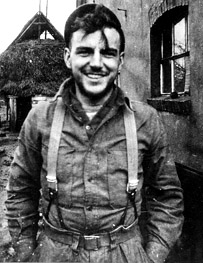 In addition to Pvt Walter Craley, ASN: 32837774, 501st Demolitions, pictured above, the victim list includes:
In addition to Pvt Walter Craley, ASN: 32837774, 501st Demolitions, pictured above, the victim list includes:
S/Sgt Leon W."Pappy"Brown ASN: 19073730, 501st Demolitions
Pvt Frank Baer ASN: 36695174 501st Demolitions
Pvt Michael Balducci ASN: 33610655, 501st Demolitions
Pvt Harold Brisco ASN:
38508635, 501st Demolitions
Cpl Bonnie Caroon ASN: 6379505, 501st Demolitions
Pvt Latcher Coney ASN: 38493384, 501st Demolitions
Pvt Wallace Diefenbach ASN:16006826, 501st Demolitions
Pvt James A. Keel ASN: 34663498, 501st Demolitions
Pfc Sam A. Lappin ASN: 33273212, 501st Demolitions
Cpl William B. Maue ASN: 15336388, 501st Demolitions
Pvt Earl F. Smith ASN: 13175240, 501st Demolitions
Pvt Robert L Rutherford ASN: 32772538, of Service Co. 501 PIR.
After WW2 a small marker was erected near the triangular repaired hole in the north seminary wall, listing the names of the known victims. Medic R. Edward O'Brien of G Co. visited the place in the late 1980's, and found the marker was crumbling from age and neglect, and that the list of names thereon was incomplete. A project was started within the 501 PIRA to raise funds and create a permanent marker to place at that repaired wall. In May, 1999, two 501st veterans, Len Cinquanta and Julius Schrader, traveled to Bastogne and placed the new marker bearing the names, ranks and serial numbers shown above. Both men passed away less than a year after placing those markers.
The Explosion and the AftermathDick Thorne of regimental S-2 told me that he left the perimeter on the evening of January 4, 1945, and ventured into town, looking for something warm to eat. He was sick of cold rations. He got a meal in the seminary, then went into the basement and crawled under a 3' stage, where he joined other troopers and went to sleep. That night, during a Luftwaffe airraid, a 500 lb German bomb crashed through the ceiling of the seminary and came through to the basement, but failed to explode.
After daylight Thorne went to the doorway facing the courtyard and was leaning against the wall when a truck pulled in and stopped.
Out from the front passenger seat, jumped Lt Roy F. Waring, who was in charge of the mine laying detail. Lt Waring was short and balding, and wore glasses. He recognized Thorne and paused to speak with him before entering the building. The lieutenant stated that he had 12 demolitions men aboard, along with 150 landmines, and that they were enroute to lay the mines in the perimeter.
Lt Waring entered the building, then came back out after a few minutes. He started toward the truck, then paused and stated "I forgot something", turned around, and re-entered the building. At that moment, a horrible explosion rocked the area. Thorne was pushed backwards against the wall and a piece of flesh struck him in the face. (Witnesses have stated they later saw flesh splattered all over the seminary and courtyard walls.)
In the 1980's, Thorne visited the Republic Bank, Greenville, TX, where Roy Waring was bank vice president. When Thorne mentioned the truck explosion, Waring broke down
right in his office, and it was evident that he had experienced tremendous 'survivor guilt' since WW2. On Thorne's next visit, he learned that Waring had passed away on 12 January, 1983. "I don't see any reason why he should have felt responsible for what happened", says Thorne. The photo of Walter Craley shown above, was provided by his good buddy, John Primerano, who took the photo on the 'Island' in Holland, October, 1944.
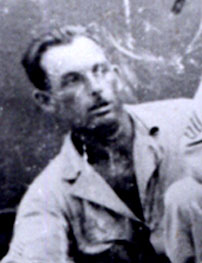 Here's a 1943 photo of Sgt Leon W. Brown, taken at Camp Mackall, N.C.
Here's a 1943 photo of Sgt Leon W. Brown, taken at Camp Mackall, N.C.
Remember The Others Who Paid A Price Beyond Measure
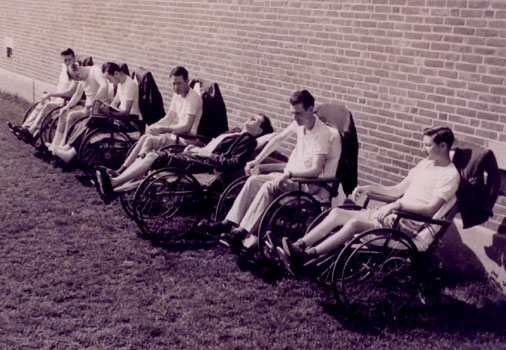 The many soldiers who were maimed, crippled and otherwise incapacitated to varying degrees, were forced to remember the war every day for the duration of their lives. Some, like Major Francis Liberatori (shown above, 3rd from left, reading) were paraplegics, who spent the duration of their lives in a wheelchair. Libby was hit in the spine near Carentan in June, 1944.
The many soldiers who were maimed, crippled and otherwise incapacitated to varying degrees, were forced to remember the war every day for the duration of their lives. Some, like Major Francis Liberatori (shown above, 3rd from left, reading) were paraplegics, who spent the duration of their lives in a wheelchair. Libby was hit in the spine near Carentan in June, 1944.
He later became president of the Eastern Paraplegic Veteran's Association at Cushing General Hospital, Framingham, MA. That club was eventually taken over by the Veterans' Administration. Libby became a successful architecht in Springfield, MA, but his serious wound also cut his life span short. He was only 55 years of age when he passed on. photo c/o P. Yankow.
*photos and text on these pages Copyright Mark Bando*
Fallen in Afghanistan September, 2010 Matthew Attalai
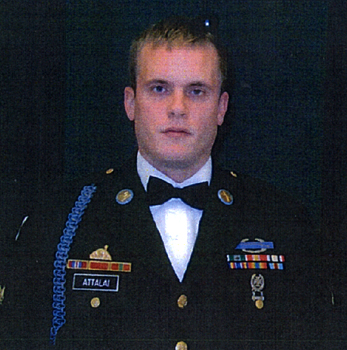 Matt was the Grandson of WWII 101st Signal Co. veteran and historian George Koskimaki. After serving
in Iraq in a Stryker Brigade of the U.S. Army, Matt received an honorable discharge but he took a job
as a civilian contractor, working in Afghanistan as a bodyguard for U.S. Government officials.
The vehicle (SUV) he was riding in near Kabul, was destroyed by a Taliban road bomb, on 6 September,
2010 and Matt died at the age of 26. His loss was a terrible blow to all who knew him.
Matt was the Grandson of WWII 101st Signal Co. veteran and historian George Koskimaki. After serving
in Iraq in a Stryker Brigade of the U.S. Army, Matt received an honorable discharge but he took a job
as a civilian contractor, working in Afghanistan as a bodyguard for U.S. Government officials.
The vehicle (SUV) he was riding in near Kabul, was destroyed by a Taliban road bomb, on 6 September,
2010 and Matt died at the age of 26. His loss was a terrible blow to all who knew him.
A salute from Trigger Time to Matthew Attalai, may he rest in peace and may God comfort George K.
and the entire Koskimaki family.































